China’s top 10 Archaeological Discoveries in 2014 Announced
From:Chinese Archaeology NetWriter:Date:2015-04-10
The annual selection organized by the State Administration of Cultural Heritage, China Cultural Relics News and China Archaeological Society announced the top 10 Archaeological discoveries in China of the year of 2014 on April 9th.1. Paleolithic sites group at Nanjiang River and Modaoshan in Yunan County, Guangdong
More than 60 locations with Paleolithic remains had been recorded in the Nanjiang River valley by the cooperative team of Guangdong Provincial Institute of Archaeology and Beijing University. An excavation at the Modaoshan location yielded more than 400 stone artifacts dating to 800 to 600 kyr BP, which triggers a hot discussion on the development of Paleolithic stone industry in southern China.
Full story:
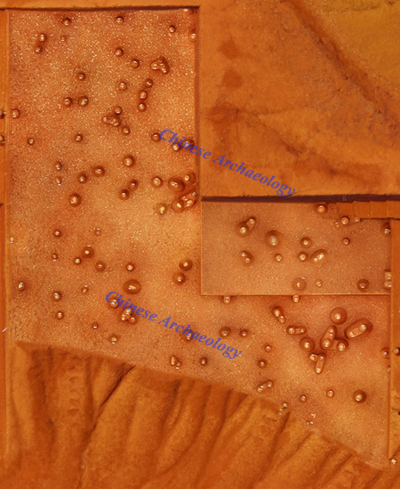
artifacts distribution of early Palaeolithic cultural layer at Modaoshan site, Guangdong province
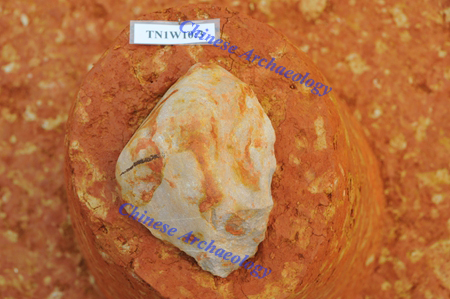
unearthed handpick in Modaoshan site, Guangdong province
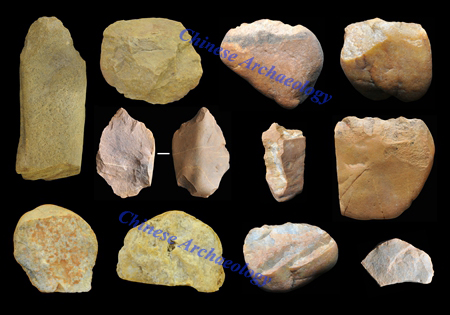
unearthed stone artifacts from late period at Modaoshan site, Guangdong province
2. The Dongzhao site in Zhengzhou City, Henan
The Dongzhao site dug by the Beijing University and Zhengzhou City Institute of Archaeology is the second walled settlement or “city” of the Xinzhai period, which has been regarded as the early phase of the Xia Dynasty – the first dynasty recorded in ancient text. The settlement had been continually occupied by the Xinzhai people, Erlitou people and the Shang people. Oracle bones of the Erlitou period and the large Shang period palace foundation found during the excavation are important for the research on the Xia - Shang transition.
Full story:
http://www.kaogu.cn/en/Special_Events/Top_10_Archaeological_Discoveries_in_China_2014/2015/0414/49896.html
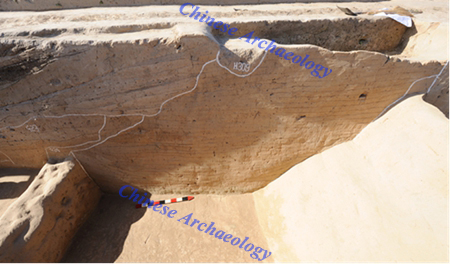
wall foundation of the walled settlement of the Xinzhai period found in Dongzhao site, Henan Province
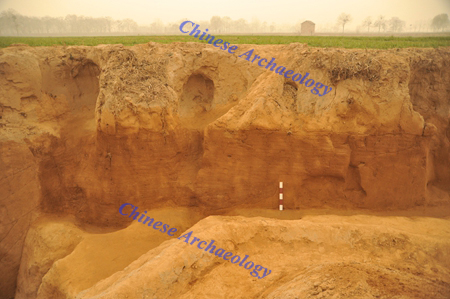
wall foundation of the walled settlement of the Erlitou period found in Dongzhao site, Henan Province
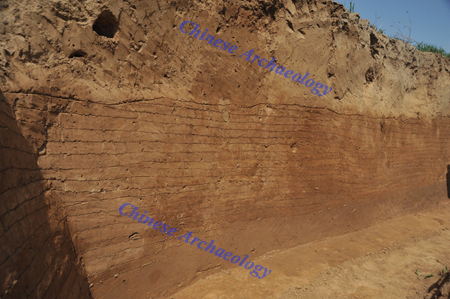
section of city foundation of Shang dynasty found in Dongzhao site, Henan Province
3. Cemetery of the Zen State at Guojiamiao, Zaoyang City, Hubei
Se, bianzhong bell set and other musical instruments had been unearthed in astonishing good condition in the burials at the Guojiamiao cemetery by archaeologists of the Hubei Provincial Institute of Archaeology. This is another eye catching discovery of the Spring and Autumn period Zen State in recent years with new data for the discussion on the relationship between the Zen and the powerful Chu state.
Full story:
http://www.kaogu.cn/en/Special_Events/Top_10_Archaeological_Discoveries_in_China_2014/2015/0410/49826.html
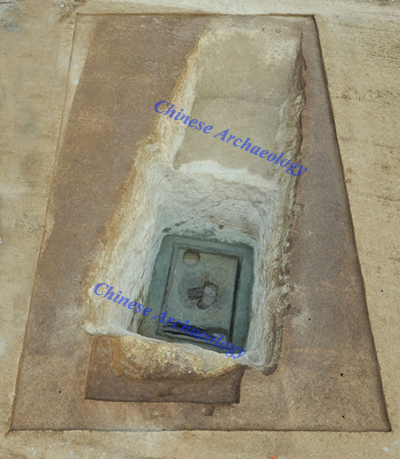
vertical view of tomb M1 at Guojiamiao cemetery, Hubei province
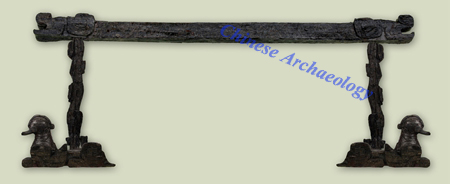
painted frames with wood carvings where chime bells and stone chimes were arranged found at Guojiamiao cemetery, Hubei province
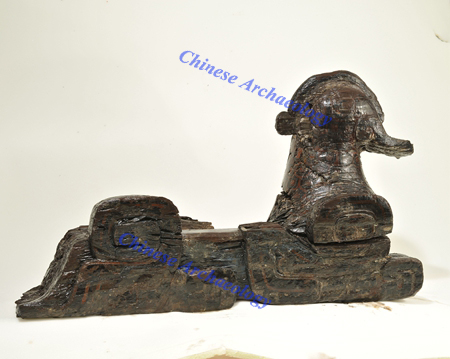
painted frames with circular carved phoenix head and painted vertical scale patterns on part of the bodies found at Guojiamiao cemetery, Hubei province
4. Dabonan cemetery in Xiangyun County, Yunan
The Dabona cemetery of the Warring States Period to Western Han Dynasty had been found in 1960s. Yunnan Provincial Institute of Archaeology and Cultural Relics had unearthed 25 burials in 2014. Six of them are large burials longer than 6 m and wider than 2.5 m. More than 280 pieces (sets) of artifacts made of bronze, iron, tin, ceramic, stone and wood were found, including weapons such as the sword, spear, axe, yue axe and arrow heads. The cemetery is very important for a better understanding of the bronze culture around the Erhai Lake area.
Full story:

skeleton and funerary objects distributed in burial M20 at Dabona site, Yunnan province
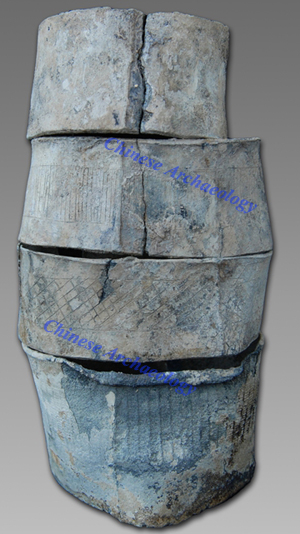
tin artifacts found at Dabona site, Yunnan province
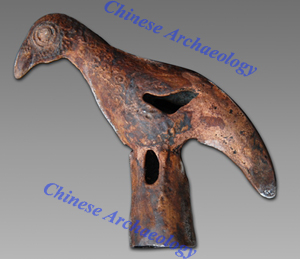
bronze ornament of cane head from M19 at Dabona site, Yunnan province
5. Early Yueyao kiln site at Jinshan, Shangyu District, Shaoxing City, Zhejiang
Nearly 200 kilns dating from the Eastern Han to Western Jin period were recorded in the survey in the Cao’e River Valley in Shangyu District by the Zhejiang Provincial Institute of Archaeology. The 2014 excavation at the Jinshan site unearthed a large number of celadon porcelain artifacts showing a clear developmental trajectory of celadon manufacture from the Eastern Han to Western Jin.
Full story:
http://www.kaogu.cn/en/Special_Events/Top_10_Archaeological_Discoveries_in_China_2014/2015/0415/49906.html

furnace kiln stove found in Jinshan, Zhejiang province
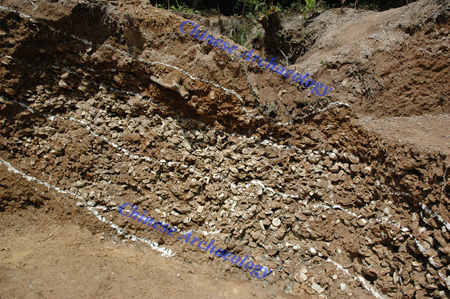
deposit layers from East Han dynasty to West Jin dynasy in Jinshan, Zhejiang province

unearthed porcelain pots in Jinshan, Zhejiang province
6. Gurugyam and Chu vthag cemeteries in Ngari, Tibet
The Gurugyam and Chu vthag cemeteries in the upper valley of glang-chen gtsang-po River had been excavated from 2012 to 2014 by the Institute of Archaeology, CASS and Tibet Institute of Cultural Heritage Preservation. In the Gurugyam cemetery, 8 Zhangzhung period burials and 3 Tibetan Period burials were found. The Zhangzhung burials dating to 1800 to 1700 BP all have a stone chamber, and the larger ones are all more than 5 m in depth. Offerings in the burials include silk, gold mask, bronze, silver, iron objects and pottery. The 5 burials found in Chu vthag cemetery dating to 1800 BP might belong to another tribe of the Zhangzhung period. Horse and sheep bones and barley grains were found in these burials, together with painted wood table, bronze mirror, textiles, glass beads and other offerings.
Full story:
http://www.kaogu.cn/en/Special_Events/Top_10_Archaeological_Discoveries_in_China_2014/2015/0410/49819.html

tomb M2 at Gurugyam Cemetery, Tibet
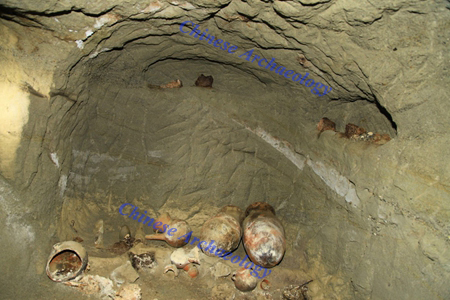
chamber of tomb M5 at Chu vthag cemetery, Tibet
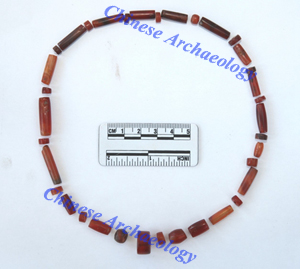
unearthed ornaments form Chu vthag cemetery, Tibet
7. Yihenaoer cemetery in Zhengxiangbai Banner, Inner Monglia
Five large Northern Wei period burials with long channel towards the underground chamber were discovered by the archaeologists from the Inner Mongolia Institute of Archaeology. Treasures found in these burials include gold coffin decoration, head ring, bell, necklace, glass bowl, lacquer cup, and belt with gold decoration, showing clear characteristics of steppe cultures. The excavators believe that these burials might the remains of the Gaoche people recorded in ancient texts.
Full story:
http://www.kaogu.cn/en/Special_Events/Top_10_Archaeological_Discoveries_in_China_2014/2015/0413/49864.html
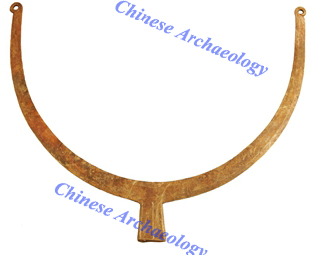
unearthed gold necklace from tomb M6 at Yihenaoer cemetery, Inner Monglis
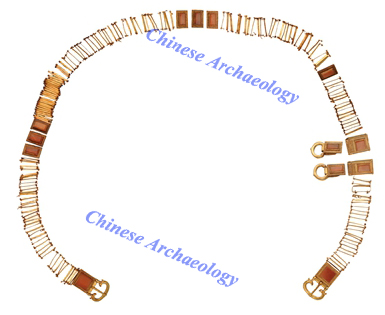
unearthed waistband from tomb M6 at Yihenaoer cemetery, Inner Monglis
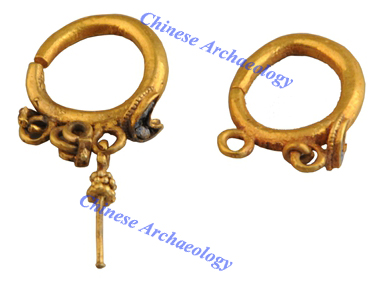
unearthed gold earrings from tomb M6 at Yihenaoer cemetery, Inner Monglis
8. Sui Dynasty Huiluocang granary site in Luoyang and Liyangcang granary site in Junxian, Henan
The Huiluocang and Liyangcang were two important state granaries along the Great Channel constructed by the Emperor Yangdi of the Sui Dynasty. Excavation conducted by the Henan Provincial Institute of Archaeology and Luoyang City Institute of Archaeology found that a standard storage pit is about 10 m in diameter and 7 to 9 m in depth, with clay painted wall and wooden floor. Grains of millet and bean were discovered in the pits. This discovery is important to understanding the Great Channel transportation system.
Full story:
http://www.kaogu.cn/en/Special_Events/Top_10_Archaeological_Discoveries_in_China_2014/2015/0410/49820.html
http://www.kaogu.cn/en/Special_Events/Top_10_Archaeological_Discoveries_in_China_2014/2015/0410/49820.html
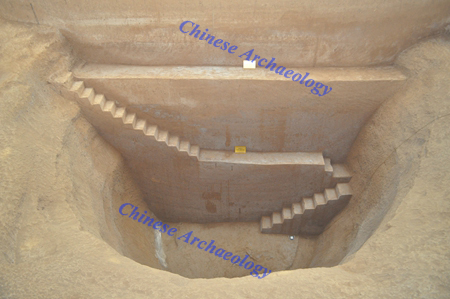
the storage pit C47 of the Huiluo granary in Luoyang, Henan province

canal for transporting grains of Huiluo granary in Luoyang, Henan province
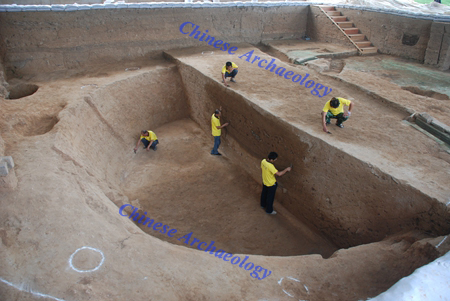
archaeologists are excavating the storage pit C6 of the Liyang granary, Henan Province
9. Liao Dynasty mining sites at Dazhuangke, Beijing
The Liao Dynasty mining sites at Dazhuangke consist of iron ore quarries, smelting sites, workshops and residential sites. Ten iron smelting furnaces were found during the excavation conducted by a cooperative team of the Beijing City Institute of Archaeology and University Of Science and Technology Beijing, which are fresh new data for the research on iron industry of the Liao Dynasty.
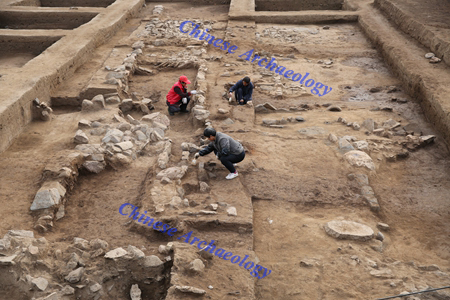
the excavation of Liao Dynasty mining site is underway at Dazhuangke, Beijing
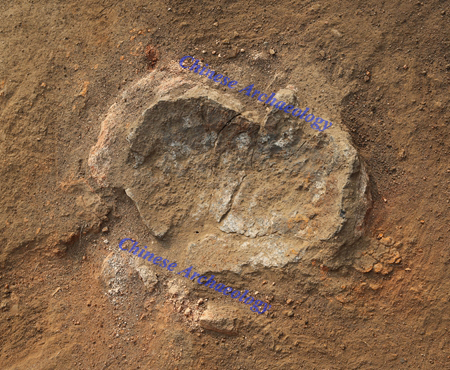
unearthed furnace remains for mining process at Dazhuangke, Beijing
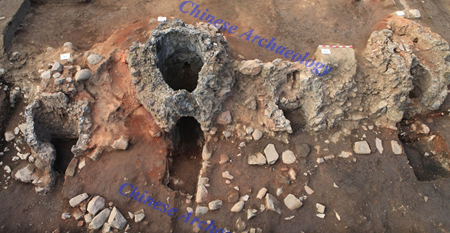
furnace remains for smelting iron found at Dazhuangke site, Beijing
10. Cemetery of Bozhou Chieftain Yang’s family in Zunyi City, Guizhou
Three new tombs had been unearthed by the Guizhou Institute of Archaeology and Cultural Relics in the cemetery of Bozhou Chieftain Yang’s family in the excavations in 2013 to 2014. The tombs belong to the 14th , 21st and 29th Chief of the Bozhou Chieftain. Artifacts found in the cemetery provide fresh data for the research on Chieftain system from the Song to Ming Dynasty.
Full story:
http://www.kaogu.cn/en/Special_Events/Top_10_Archaeological_Discoveries_in_China_2014/2015/0410/49818.html

Tomb M2 of the Yang Jian couple, who is the 21st generation chieftain (Tusi) in Bozhou and the first tusi during the Ming dynasty

gold cup unearthed from the lady's chamber of tomb M3 in Bozhou, Guizhou province
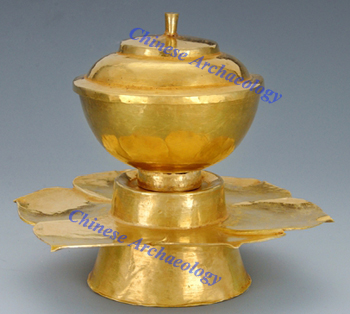
gold zhan cup unearthed from tomb M3 in Bozhou, Guizhou province
The top 10 important archaeological discoveries for 2014 were selected from several hundreds of archaeological excavations conducted last year. The time period ranges from the Paleolithic period to the Ming dynasty. The sites are from 9 provinces. Noticeably, there is an increase in the number of sites in the frontier regions, which well indicates the balanced development in archaeological excavations and researches. These 10 discoveries cover a rich variety of sites, ranging from the cemetery, kiln, Buddhist remains, granary site and mining sites, some of them are relatively rare archaeological findings. These discoveries provide crucial information and bring new perspective to academic research.
After 24 years, the selection of the top 10 important archaeological discoveries has become an important platform to introduce new archaeological researches to both the academic circle and the public.

